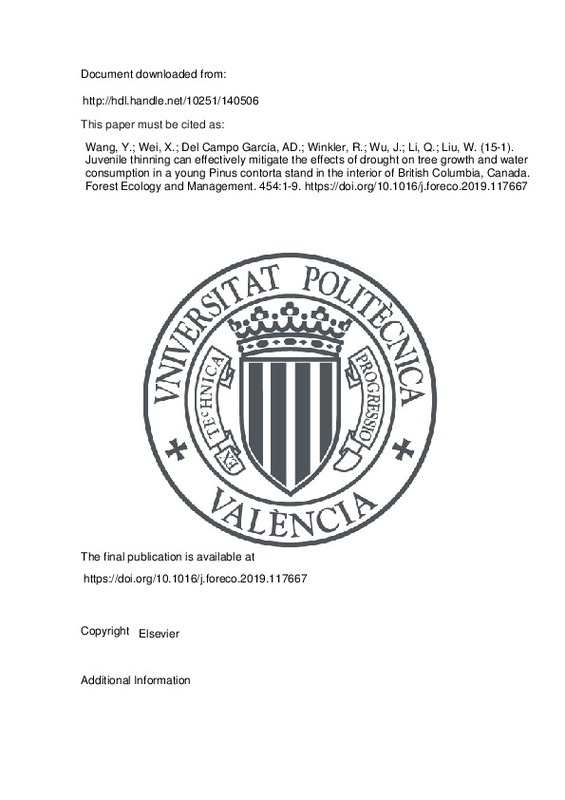JavaScript is disabled for your browser. Some features of this site may not work without it.
Buscar en RiuNet
Listar
Mi cuenta
Estadísticas
Ayuda RiuNet
Admin. UPV
Juvenile thinning can effectively mitigate the effects of drought on tree growth and water consumption in a young Pinus contorta stand in the interior of British Columbia, Canada
Mostrar el registro sencillo del ítem
Ficheros en el ítem
| dc.contributor.author | Wang, Y.,
|
es_ES |
| dc.contributor.author | Wei, X.
|
es_ES |
| dc.contributor.author | Del Campo García, Antonio Dámaso
|
es_ES |
| dc.contributor.author | Winkler, R.,
|
es_ES |
| dc.contributor.author | Wu,J.
|
es_ES |
| dc.contributor.author | Li, Q.
|
es_ES |
| dc.contributor.author | Liu, w.
|
es_ES |
| dc.date.accessioned | 2020-04-08T05:58:55Z | |
| dc.date.available | 2020-04-08T05:58:55Z | |
| dc.date.issued | 2019-12-15 | es_ES |
| dc.identifier.issn | 0378-1127 | es_ES |
| dc.identifier.uri | http://hdl.handle.net/10251/140506 | |
| dc.description.abstract | [EN] Large-scale forest disturbances including mountain pine beetle infestation and forest fires have generated overstocked lodgepole pine stands in the interior of British Columbia. A critical need is to determine sustainable management strategies to ensure their healthy growth and provision of various ecological functions under increased drought risk due to climate change. In 2016, a field experiment was established to study the effects of juvenile thinning on carbon assimilation and water use at the both tree- and stand-scales in a 16-year old lodgepole pine stand from June to October in 2016 and 2017. This study located northeast of Penticton, British Columbia, included two thinning treatments (T1: 4500 stems per ha; and T2: 1100 stems per ha) and one control (C: 27,000 stems per ha), randomly assigned in three blocks. Sap flow and microclimatic variables were continuously monitered in one plot of each treatment in one block, while tree diameter at breast height were measured across the three blocks. The results showed that C had the lowest tree radial growth (0.14 mm(2)/d), sap flow velocity (64.61 g/cm(2)d), and highest stand transpiration (4.36 mm/d), while T2 had the highest tree radial growth (1.28 mm(2)/d), sap flow velocity (149.14 g/cm(2)d), and lowest stand transpiration (0.36 mm/d) over the two-year study period. Significant differences of tree radial growth and sap flow velocity between T1 and T2 only occurred under the drought condition (in the summer season of 2017), with T2 having a significant higher resistant index of sap flow velocity than C and T1, by taking advantage of the change in microclimatic conditions following intense thinning. At the stand-level, only the stand transpiration of T1 statistically decreased in the drought year. We conclude that the thinning plays a significant and positive role in maintaining tree growth and water consumption in the short term, and the more heavily thinning (T2) would be more effective to mitigate the drought effect in young overstocking lodgepole pine forests in terms of water consumption. These findings improve our understanding on how thinning can be used to manage ecological responses to forest practices in a changing climate. | es_ES |
| dc.description.sponsorship | The project was supported by the Collaborative Research and Development (CRD) Grants from Natural Sciences and Engineering Research Council of Canada (NSERC). We thank Dr. Guang Qi, Dr. Xin Yang, Dr. Peng Zhang, Dr. Yingchun Liao for help in the field experiments, Dr. Trevor Blenner, Dr. Russell Smith and Dr. David Spittlehouse for providing the data of stand density, leaf area index and long-term climatic condition, Dr. Paramjit Gill for statistical advice, and Dr. David Scott, Dr. Tongli Wang and Krysta Giles-Hansen for valuable comments on the manuscript. We are grateful to the management faculty of Upper Penticton Watershed for the access to the study site and for their support toward our ecohydrological research programs. Y. Wang, X. Wei and A. del Campo designed the study; Y. Wang, X. Wei and A. del Campo led the field data collection and analyses; Y. Wang and X. Wei led the writing of the manuscript. All authors contributed to the drafts and gave final approval for publication. Professor del Campo was beneficiary of a "Salvador de Madariaga" grant (PR2015-00635) funded by the Spanish Government. | es_ES |
| dc.language | Inglés | es_ES |
| dc.publisher | Elsevier | es_ES |
| dc.relation.ispartof | Forest Ecology and Management | es_ES |
| dc.rights | Reserva de todos los derechos | es_ES |
| dc.subject | Juvenile thinning | es_ES |
| dc.subject | Thinning intensity | es_ES |
| dc.subject | Pinus contorta | es_ES |
| dc.subject | Carbon and water processes | es_ES |
| dc.subject | Sap flow | es_ES |
| dc.subject | Drought | es_ES |
| dc.subject.classification | TECNOLOGIA DEL MEDIO AMBIENTE | es_ES |
| dc.title | Juvenile thinning can effectively mitigate the effects of drought on tree growth and water consumption in a young Pinus contorta stand in the interior of British Columbia, Canada | es_ES |
| dc.type | Artículo | es_ES |
| dc.identifier.doi | 10.1016/j.foreco.2019.117667 | es_ES |
| dc.relation.projectID | info:eu-repo/grantAgreement/MECD//PR2015-00635/ | es_ES |
| dc.rights.accessRights | Abierto | es_ES |
| dc.contributor.affiliation | Universitat Politècnica de València. Departamento de Ingeniería Hidráulica y Medio Ambiente - Departament d'Enginyeria Hidràulica i Medi Ambient | es_ES |
| dc.description.bibliographicCitation | Wang, Y.; Wei, X.; Del Campo García, AD.; Winkler, R.; Wu, J.; Li, Q.; Liu, W. (2019). Juvenile thinning can effectively mitigate the effects of drought on tree growth and water consumption in a young Pinus contorta stand in the interior of British Columbia, Canada. Forest Ecology and Management. 454:1-9. https://doi.org/10.1016/j.foreco.2019.117667 | es_ES |
| dc.description.accrualMethod | S | es_ES |
| dc.relation.publisherversion | https://doi.org/10.1016/j.foreco.2019.117667 | es_ES |
| dc.description.upvformatpinicio | 1 | es_ES |
| dc.description.upvformatpfin | 9 | es_ES |
| dc.type.version | info:eu-repo/semantics/publishedVersion | es_ES |
| dc.description.volume | 454 | es_ES |
| dc.relation.pasarela | S\401103 | es_ES |
| dc.contributor.funder | Ministerio de Educación, Cultura y Deporte | es_ES |







![[Cerrado]](/themes/UPV/images/candado.png)

